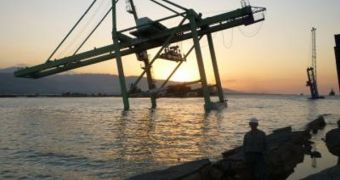Soon after the January 12, magnitude 7 earthquake struck the impoverished nation of Haiti, researchers at the University of Washington were deployed in the region. Their main objective was to conduct a study of how the fault lines in the region were modified following the main tremor, and the magnitude 6.2 aftershock that followed on January 20. Now the team, which was led by civil and environmental engineering professor Marc Eberhard, releases its reports, both to the national Earthquake Engineering Research Institute and the United States Geological Survey (USGS). These institutions funded the trip to Haiti, as well as the costs associated with deploying complex equipment in the region.
The team, featuring five scientists, found that the primary earthquake did not cause any surface damage that could indicate the presence of a fault line. Geologists know the contact area between the Gonave microplate and the Caribbean plate is there, passing very close to the Haitian capital Port-au-Prince. The contact area forms the Enriquillo-Plantain Garden fault system, which is the one that released its energy and produced the devastating tremor. The UW researchers installed four instruments at various sites around the area, to help them measure aftershocks, and also pinpoint the epicenter.
The UW group was also responsible for providing engineering support to the United States Southern Command, which is in charge of coordinating all military activities that the US conducts in Central and South America. The new report also highlighted something that became painfully obvious after the tremor. The large number of human lives that were lost – 230,000 by the latest accounts – could have been avoided if some of the buildings in Port-au-Prince would have been designed and constructed to resist earthquakes. Given the fact that they were erected on a fault line, authorities shouldn't have granted building permits, and allow for improvised structures to cover a large area.
As the nation prepares to rebuild, it may be a good idea, the UW team proposes, that authorities place more emphasis on simple, yet effective, earthquake engineering. More quality control, and more attention to working concrete and masonry, could see the nation suffering a lot less if a new tremor strikes. The researchers add that the equipment they installed could help predict the risk of another earthquake striking soon, but only to a certain degree. There is currently no method of saying for sure whether a tremor takes place or not, and when it happens if it does.
“Usually when I go to earthquakes I find that the amount of damage is less than what appears on the television. In this case it was much more. The main reason for the difference is that usually when you see earthquake coverage the cameras will focus on one place that's really damaged, and you don't realize that around it there are plenty of things that are just fine. In this case, the cameras focused on one place that's really damaged, but because the cameras have a limited field of view you don't realize that the cameras could be panned 360 degrees and you would see the same thing,” says Eberhard.

 14 DAY TRIAL //
14 DAY TRIAL //